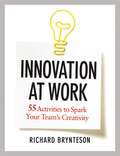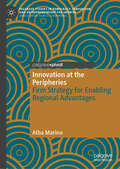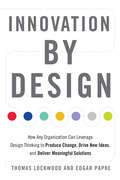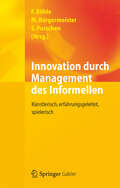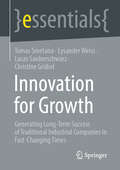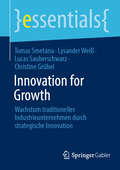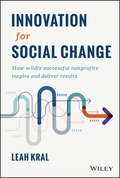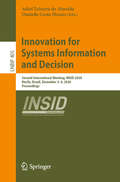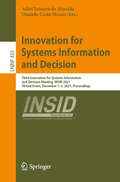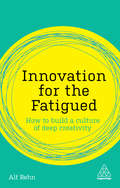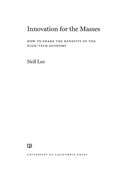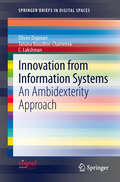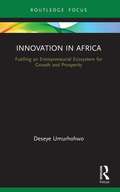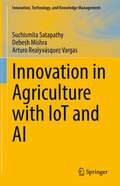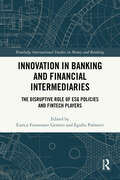- Table View
- List View
Innovation at Work: 55 Activities to Spark Your Team's Creativity
by Richard BryntesonMore and more organizations are realizing that the only hope for survival in an ultracompetitive landscape is through innovation: developing new and better products and services - and creating efficient processes for delivering them. Designed for managers, team leaders, and trainers looking to promote innovation at work, the book is packed with 55 activities to help participants: - Employ "visioning" and "brainwriting" processes to achieve breakthroughs - Cultivate a sense of curiosity and inquisitiveness - Utilize methods of deep observation - Build networks for open source innovation and creative collaboration - Use images to spark ideas and connections - Develop out-of-the-box techniques for problemsolving - Deal with failure successfully and productively - Spot trends and determine "the next step" Innovation at Work contains worksheets, questions, and case studies to inspire discussion as well as assessments for determining managers' openness to innovation. Innovation isn't just about the next iPod, and it's not just for scientists. This handy book provides readers with a roadmap for fostering creativity and innovation in any team in any industry.
Innovation at the Boston Consulting Group
by Robert G. Eccles Penelope Rossano Das NarayandasThis case is about how the Boston Consulting Group has approached innovation from its founding to the present day. It discusses the role of the firm's talent market and client market in developing these innovations.
Innovation at the Peripheries: Firm Strategy for Enabling Regional Advantages (Palgrave Studies in Democracy, Innovation, and Entrepreneurship for Growth)
by Alba MarinoInnovation scholarship has traditionally leaned towards the analysis of innovation processes linked to conditions found in ‘core’ areas; well-functioning economic hubs and dynamic high-technology sectors. Although more recent work on innovation in emerging economies has begun to broaden the picture, innovation in the ‘peripheral’ regions and sectors of developed economies is still largely unexplored. This book is a unique exploration of how innovation processes operate in peripheral regions, while also looking at the key drivers and challenges organizations face in peripheral areas as they strive to innovate and compete globally. Adopting interdisciplinary approaches from management studies, economics and geography, this book blends theory-building and quantitative approaches to investigate the periphery and innovation nexus, with a focus on bibliometric approach, topic modelling, and patent-based analysis. It will be of great interest to scholars and students of innovation, strategic management, regional development and sustainability.
Innovation aus Leidenschaft: So gestalten Unternehmen kraftvoll eine passende Innovationskultur (essentials)
by Frank WeberGibt es nicht schon viele Bücher zum Thema Innovation? Ja! Doch Hand aufs Herz, so richtig erfolgreich sind die Innovationsprozesse in den wenigsten Unternehmen. Das ist nicht nur bedauerlich. Das ist gefährlich. Innovation ist weit mehr als ein Imagefaktor. Innovation ist überlebenswichtig – schon gar im Kontext der VUCA-Welt und immer kürzeren Innovationszyklen. Ohne die Fähigkeit zu innovieren, gefährden Unternehmen ihre Marktpositionierung. Die Liste der Ansätze, die Innovationsfähigkeit zu steigern ist lang (z.B.: Innovation Labs, Design Thinking, agile Methoden, Kreativitätstechniken). Hier wird viel probiert und kopiert – oft mit durchwachsenen Erfolgen. Warum? Vor allem, weil die Vorhaben, die Innovationsfähigkeit zu steigern, nicht mit der eigenen Unternehmenskultur abgestimmt sind. Nur das, was zur eigenen Kultur passt, hat die Chance, zum Erfolgstreiber von Innovationen zu werden. Und nur dann kann man in den Unternehmen erfolgreich mit den passenden Tools und Methoden arbeiten. Dieses Buch gibt seinen Leserinnen und Lesern Inspirationen, wie man im Unternehmen den passenden Rahmen baut, damit sich Innovationen aus Leidenschaft entfachen lassen.
Innovation by Creativity: Fifty-One Tools on How to Solve Problems Creatively
by Max Van Leeuwen Hans TerhurneFeatures a tool selector by which the reader can determine which tool is appropriate for the various components of a creative program. This title helps you in the cooperation of imagination and sense through the use of different methodologies.
Innovation by Design: How Any Organization Can Leverage Design Thinking to Produce Change, Drive New Ideas, and Deliver Meaningful Solutions
by Thomas Lockwood Edgar PapkeWhy are some organizations more innovative than others? How can we tap into, empower, and leverage the natural innovation within our organizations that is so vital to our future success?Now more than ever, companies and institutions of all types and sizes are determined to create more innovative organizations. In study after study, leaders say that fostering innovation and the need for transformational change are among their top priorities. But they also report struggling with how to engage their cultures to implement the changes necessary to maximize their innovative targets.In Innovation by Design, authors Thomas Lockwood and Edgar Papke share the results of their study of some of the world&’s most innovative organizations, including:The 10 attributes leaders can use to create and develop effective cultures of innovation.How to use design thinking as a powerful method to drive employee creativity and innovation.How to leverage the natural influence of the collective imagination to produce the &“pull effect&” of creativity and risk taking.How leaders can take the &“Fifth Step of Design&” and create their ideal culture.Innovation by Design offers a powerful set of insights and practical solutions to the most important challenge for today&’s businesses—the need for relevant innovation.
Innovation durch Management des Informellen
by Markus Bürgermeister Fritz Böhle Stephanie PorschenIn diesem Buch zeigen die Autoren, wo die Erfolgspotenziale bei Organisationen liegen und wie sie mithilfe von Managementstrategien sowie Organisations-, Personal- und Kompetenzentwicklungskonzepten realisiert werden können. Die im Verbundprojekt KES-MI (www.kes-mi.de) erarbeiteten Instrumente zielen darauf ab, Unbestimmtheit und Offenheit als Charakteristika innovativer Arbeitsprozesse nicht nur zuzulassen, sondern diese Eigenschaften als Potenzial zur Steigerung der Innovationsfähigkeit zu nutzen und zu fördern.
Innovation for Growth: Generating Long-Term Success of Traditional Industrial Companies in Fast-Changing Times (essentials)
by Lucas Sauberschwarz Lysander Weiss Tomas Smetana Christine GrübelDigitalization, sustainability, global competition and geopolitical conditions are presenting traditional industrial companies with major new challenges. Strategic innovation is needed to successfully address these by identifying, developing and realizing suitable new business potentials. With a sound scientific basis and numerous practical examples, this book explains the necessary dynamic capabilities for strategic innovation and shows a systematic approach to establishing and applying them in traditional industrial companies. For decision-makers, the book serves as both a wake-up call and a solution for achieving lasting success in the highly dynamic market environment of the 21st century.
Innovation for Growth: Wachstum traditioneller Industrieunternehmen durch strategische Innovation (essentials)
by Lucas Sauberschwarz Lysander Weiß Tomas Smetana Christine GrübelDigitalisierung, Nachhaltigkeit, globaler Wettbewerb und geopolitische Rahmenbedingungen stellen traditionelle Industrieunternehmen vor neue Herausforderungen. Um diese mit der Identifizierung, Entwicklung und Realisierung passender Geschäftspotenziale erfolgreich zu adressieren, braucht es strategische Innovation. Wissenschaftlich fundiert und mit zahlreichen Praxisbeispielen erläutert dieses Buch die dazu notwendigen dynamischen Fähigkeiten für Organisationen und zeigt einen systematischen Ansatz, um diese zu etablieren und anzuwenden. Für Entscheidungsträger dient das Werk zugleich als Weckruf und Lösung, um im hochdynamischen Marktumfeld des 21. Jahrhunderts dauerhaft erfolgreich zu sein.
Innovation for Social Change: How Wildly Successful Nonprofits Inspire and Deliver Results
by Leah KralTransform your nonprofit&’s ability to innovate for the future In Innovation for Social Change, distinguished author Leah Kral delivers a practical manual for nonprofits and charitable organizations seeking to innovate their way toward new and exciting possibilities. In the book, you&’ll explore hands-on design thinking strategies and techniques you can use as a disciplined process for exploring what&’s possible in your organization. You&’ll learn how to identify hidden needs, deal with the knock-on effects of your ideas, and focus your efforts where they can have the most impact. You&’ll also discover how to transform your ideas into action, building small experiments and learning from them before scaling them up organization-wide, and how to create an ecosystem for everyday innovation. Finally, the author explains what we can learn from social entrepreneurs as they boldly challenge the status quo. The book also includes: Six basic and mutually reinforcing principles that will help you become more innovative today Instructive and engaging case studies from nonprofits with a variety of missions, visions, and political backgrounds Strategies for applying straightforward principles from economics to supercharge nonprofit innovationA can&’t-miss roadmap to creative innovation, Innovation for Social Change will earn a place in the libraries of nonprofit board members, managers, fundraisers, and other professionals in the charitable space.
Innovation for Society: The P.S.I. Approach
by Joelle Forest Marianne Chouteau Céline NguyenIn a context marked by unprecedented challenges (the struggle against inequalities, climate change, etc.), innovation appears to be the readymade universal scapegoat. Innovation for Society, however, suggests that we look at innovation differently, by inviting us to innovate with consciousness. To do this, the authors introduce an approach they call Penser le Sens de l’Innovation (P.S.I., or “thinking about the meaning of innovation”), comprising a set of tools largely from the humanities and social sciences (observation, cartography, creativity, storytelling, etc.) to lead us to this “meaning”. By considering the question of “meaning” from the point of view of both direction and signification, the authors rehabilitate the eminently political question of knowing which innovations we choose for which societies.
Innovation for Systems Information and Decision: Second International Meeting, INSID 2020, Recife, Brazil, December 2–4, 2020, Proceedings (Lecture Notes in Business Information Processing #405)
by Adiel Teixeira de Almeida Danielle Costa MoraisThis book constitutes the refereed proceedings of the Second International Meeting on Innovation for Systems Information and Decision meeting, INSID 2020, held in Recife, Brazil, in December 2020. Due to the COVID-19 pandemic the conference was held virtually. The 8 papers presented in this volume were carefully reviewed and selected from a total of 84 submissions to the main conference. The selected papers reflect methodological improvements and advances in Multicriteria Decision-Making/Multicriteria Decision-Aid (MCDM/MCDA) oriented toward real-world applications and contribute to the understanding of relevant developments of current research on and future trends of Innovation for Systems Information and Decision.
Innovation for Systems Information and Decision: Third Innovation for Systems Information and Decision Meeting, INSID 2021, Virtual Event, December 1–3, 2021, Proceedings (Lecture Notes in Business Information Processing #435)
by Adiel Teixeira de Almeida Danielle Costa MoraisThis book constitutes the refereed proceedings of the Third International Meeting on Innovation for Systems Information and Decision, INSID 2021, which was held during December 1-3, 2021. The conference was initially planned to take place in Recife, Brazil, but changed to a virtual meeting due to the COVID-19 pandemic. The 9 full papers presented in this volume were carefully reviewed and selected from a total of 76 submissions. They reflect methodological improvements and advances in multi-criteria decision-making/multi-criteria decision-aid (MCDM/MCDA) oriented toward real-world applications, which contribute to the understanding of relevant developments of current research on and future trends of innovation for systems information and decision.
Innovation for the Fatigued: How to Build a Culture of Deep Creativity (Kogan Page Inspire Ser.)
by Alf RehnHow many presentations on innovation have there been recently? Thousands? Millions? We are experiencing 'innovation fatigue': we feel cheated by the endless rounds of consultants who come into our organizations, deliver conceptual models that don't stick with the realities of business and then leave again. Companies and teams are left feeling more deflated than before, and with not one idea that's impacted the bottom line. Innovation for the Fatigued argues it is worth fighting for the concept and study of innovation in organizations.Business leaders are always looking over their shoulders for the next Uber moment to overtake them, and they recognize that innovation needs to be a top priority. But how does one innovate? This book is the antidote to the empty promises that pervade the innovation industry. By designing a company culture that nurtures ideas, but also defends against incrementalism and fads, we can rediscover the powerful basics of imagination, empathy, play and courage, which are all instrumental in delivering real impactful innovation. Innovation for the Fatigued will detail where companies have got innovation wrong, whilst celebrating and studying the ones that lead the way. With unique, relatable and varied examples, renowned innovation and creativity professor Alf Rehn provides a practical model for getting innovation back on track, and instilling change at speed with real concern for market demands.
Innovation for the Masses: How to Share the Benefits of the High-Tech Economy
by Neil LeeAn engaging, solutions-oriented look at how cities and nations can better navigate issues of innovation and inequality. From San Francisco to Shanghai, many of the world's most innovative places are highly unequal, with the benefits going to a small few. Rather than simply asking how we can create more high-tech cities and nations, Innovation for the Masses focuses on places that manage to foster innovation while also delivering the benefits more widely and equally. In this book, economist Neil Lee draws on case studies of Taiwan, Sweden, Austria, and Switzerland to set out how innovation can be successfully balanced toward equity. As high-tech economies around the world suffer from polarized labor markets and political realities that lock in these problems, this book looks beyond the United States to other models of distributing a leading-edge economy. Lee emphasizes the active role of the state in creating frameworks to ensure that benefits are broadly shared, and he reveals that strong policies for innovation and shared prosperity are mutually reinforcing. Ultimately, Innovation for the Masses provides a vital window into alternative models that prioritize equity, the roadblocks these models present, and what other countries can learn from them going forward.
Innovation from Emerging Markets: From Copycats to Leaders
by Lourdes Casanova Fernanda Cahen Anne MirouxIn recent years, emerging markets have come to represent the largest share of global GDP and have made gains in economic development and political influence. In turn, emerging market companies have taken on a new level of importance in driving innovation, local development and global competition. Advancing an integrative view that captures the diversity of innovation among companies in emerging markets, this book highlights the rapid evolution of emerging markets from imitators to innovation leaders. Building upon research conducted by the Emerging Multinational Research Network (EMRN) in collaboration with several universities in North and South America, Europe and China, this rich and expansive collection includes studies of innovation in regions yet to receive focused analysis in the field. The authors also re-examine dominant theories of innovation and capability creation based on a broad range of case studies and research insights. Offering a taxonomy of emerging market innovations, this collection reveals the unique drivers, types, and outcomes of innovation in emerging markets.
Innovation from Information Systems
by Tatiana Bouzdine-Chameeva C. Lakshman Olivier DupouetRelying on the extensive study of a multi-national Company, this work proposes a process view of the way firms balance tensions between exploring new knowledge and exploiting old one. First, ideas are generated throughout the organization. These ideas are funneled towards specific project teams that further develop and refine them. Second, projects are assessed by the top management. Agreed projects are then progressively transformed into exploitable products, following a transformative learning process. We then make propositions regarding the role information systems can play in sustaining this process. Regarding the first phase of the cycle, we will focus on systems that help in sustaining idea generation and in balancing explorative and exploitive projects in the technologies portfolio of the firm. Regarding the second phase, we will look at information systems that could be useful in supporting knowledge transfer and knowledge interpretation across a multi-national company.
Innovation in ASEAN: Change and Development
by Vanessa RattenThis book focuses on innovation in the ASEAN such as Brunei, Indonesia, Malaysia andSingapore to demonstrate that it is contextually different to other geographic regionsdue to the climate, government structure and history. This book shows that innovationdevelops based on cultural and societal conditions.The aim of this book is to focus on how innovation occurs in Brunei, Indonesia,Malaysia and Singapore. Thereby focusing on the unique country elements of eachcountry but also exploring the integrated history of these countries. The book highlightsthese countries together due to Brunei and Singapore previously being part of Malaysiaand the fact that they are in close geographic proximity. In addition, this book statesthat all countries share the same language (Bahasa Indonesia or Malay), which is acommon cultural feature of these countries. In this book chapters focus on differentforms of innovation from social to technological. Thereby offering a holistic perspectiveabout how innovation occurs within and between these countries.
Innovation in Africa: Fuelling an Entrepreneurial Ecosystem for Growth and Prosperity (Routledge Focus on Business and Management)
by Deseye UmurhohwoThis book emphasizes the need for promoting innovation on the African continent. It identifies the roadblocks for entrepreneurs and discusses ways for developing an ecosystem for innovators to pave a way through the barriers and create ground-breaking products and new technologies which meet consumers’ needs in Africa. In order to stimulate innovation in African countries, there is the need for a more appropriate approach for innovation to occur in a context of international openness to knowledge. This book adopts a practical approach, demonstrating how innovation is an important driver of economic growth and competitiveness. It shows that innovation in Africa should be driven by local people, in response to local problems, and that open technology and knowledge sharing are vital to this project. It further explores key enablers such as the discovery of innovative talent, overcoming barriers, building strategic partnerships and promoting innovation across the continent. The book places emphasis on the creation of an innovation ecosystem as a value-creating tool by stakeholders for nation building and growth in Africa. This book will be of interest to researchers, students, international agencies, governments, businesses and individuals interested in the field of innovation and its potentials. It will also be relevant to investors, manufacturers and other stakeholders involved in the economic development of Africa.
Innovation in Agriculture with IoT and AI (Innovation, Technology, and Knowledge Management)
by Arturo Realyvásquez Vargas Suchismita Satapathy Debesh MishraThis book examines different innovations in worldwide agricultural-systems including the applications of artificial intelligence (AI), internet of things (IoT) and features of machine learning (ML) for the benefits of the farm-community. Specifically, it examines the use of agricultural equipment and IoT to reduce physical stress; innovative equipment that measure and reduce mental work load; and innovative techniques to help with employee safety. Featuring case studies and future implications, this book is an excellent guide for academics and researchers in the agri-sector.
Innovation in Architecture: A Path to the Future
by Alan J. Brookes Dominique PooleIn this highly original book, through a series of essays, key architects and engineers in Europe, Australia, and the USA describe the ideas and development behind the innovative technology in their chosen projects, with the emphasis being on the means of production and the links between design and the manufacturing process.
Innovation in Banking and Excessive Loan Growth
by Daniel C. Hardy Alexander F. TiemanA report from the International Monetary Fund.
Innovation in Banking and Financial Intermediaries: The Disruptive Role of ESG Policies and Fintech Players (Routledge International Studies in Money and Banking)
by Egidio Palmieri Enrico Fioravante GerettoThis volume provides a thorough examination of the drivers of recent innovations in the financial sector. The book's distinctive feature lies in its unique integration of two subjects of particular relevance in the fields of finance and banking: Environmental, Social and Governance (ESG) policies and Fintech innovations. This integration provides a comprehensive perspective on their interdependent influence and implications for financial intermediaries and the financial sector.The book offers an analysis of the theoretical and empirical essentials behind these transformations, including empirical analyses of the bank-specific impact of ESG factors on ratings, loan quality and internal control systems. While facilitating broader research regarding sustainable finance and providing essential findings for those hoping to comprehend and implement the aforementioned strategies into practice, the volume showcases the increasing significance of environmental issues in financial decision-making. Finally, the book addresses the way financial technology innovations are causing disruption to so-called "traditional" credit markets and affecting banking stability in general. It offers a comparison of green and brown Fintech, examining their safety and sustainability dimensions, and discuss the trade-off between progress and the need for responsibility.This work serves to bridge a significant gap between theoretical and practical approaches, providing findings and implications for researchers and academics studying finance, technology and sustainability. Through multiple methodologies, the authors explore changes related to ESG and Fintech, facilitating deeper understanding of their operational implications and significance.
Innovation in Branding and Advertising Communication (Routledge Research in Communication Studies)
by Lluís Mas-ManchónThis book addresses innovative and new aspects of branding and advertising communication, by drawing on a broad, interdisciplinary range of theories, methods and techniques– from body image, identity and mental imagery, to self-exposure and LCM4P – intersecting with branding and advertising constructs and practices. The editor combines the perspectives of an international group of scholars to establish new theoretical frameworks and proposes new methodological designs to conduct comprehensive studies in the field. Situated at the intersection between society, communication and psychology, each chapter presents an innovative approach to branding and advertising research. The book explores topics such as social robots, body image in video advertising, brand personality, transmedia personal brands, erotic content in commercial images, and brand fandom communities. Innovation in Advertising and Branding Communication will be a valuable resource for scholars working in the fields of marketing communication, branding and advertising, online communication, sociology, social psychology and linguistics
Innovation in Brazil: Advancing Development in the 21st Century (Routledge Studies in Innovation, Organizations and Technology)
by Ben Ross Schneider Elisabeth B. Reynolds Ezequiel ZylberbergSince the early 2000s, state-led and innovation-focused strategies have characterized the approach to development pursued in countries around the world, such as China, India, and South Korea. Brazil, the largest and most industrialized economy in Latin America, demonstrates both the opportunities and challenges of this approach. Over the course of nearly 20 years, the Brazilian government enacted various policies and programs designed to strengthen the country’s capacity to innovate. It increased spending on science and technology, encouraged greater collaboration between industry and universities, and fostered the creation of new institutions whose primary aim was to facilitate greater private research and development (R&D) spending. In this book, the editors unite a diverse array of empirical contributions around a few key themes, including public policies, institutions and innovation ecosystems, and firms and industries, that collectively make the case for a new, forward-looking innovation agenda aimed at addressing persistent challenges and exploiting emerging opportunities in Brazil. Its conclusions offer valuable lessons for other developing and emerging economies seeking to accelerate innovation and growth in the modern age. With its interdisciplinary and wide-ranging contribution to the study of innovation, as well as attention to broader policy implications, this book will appeal to scholars and professionals alike.
